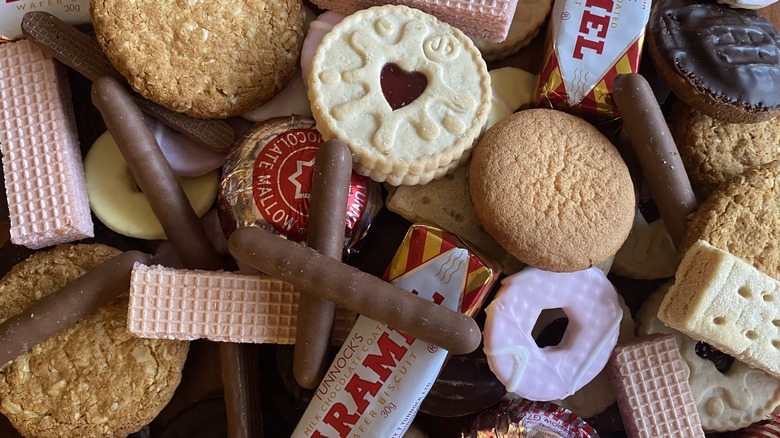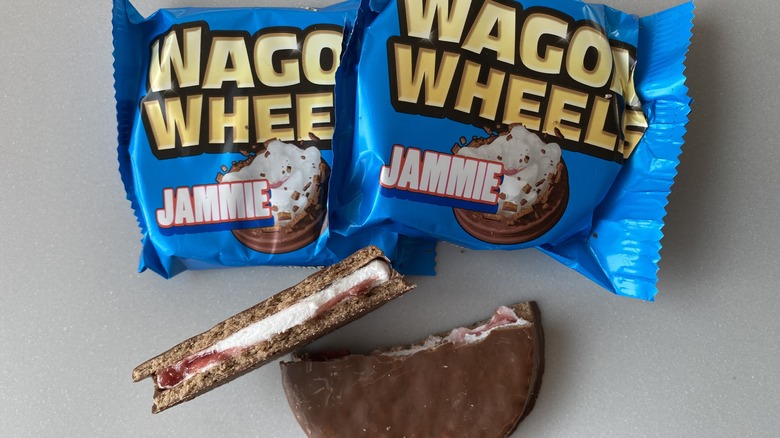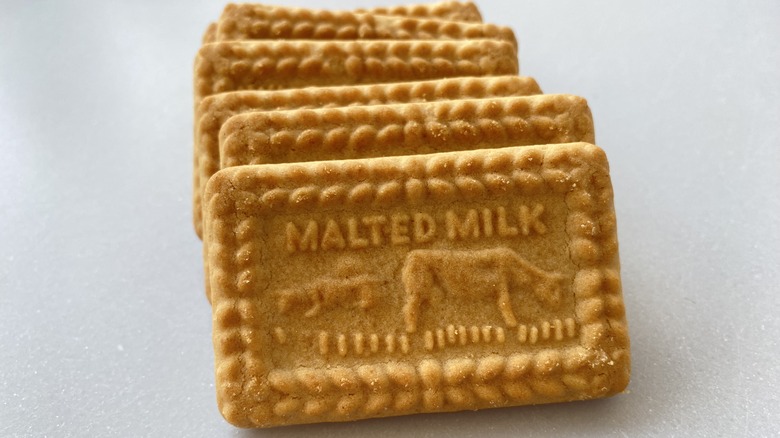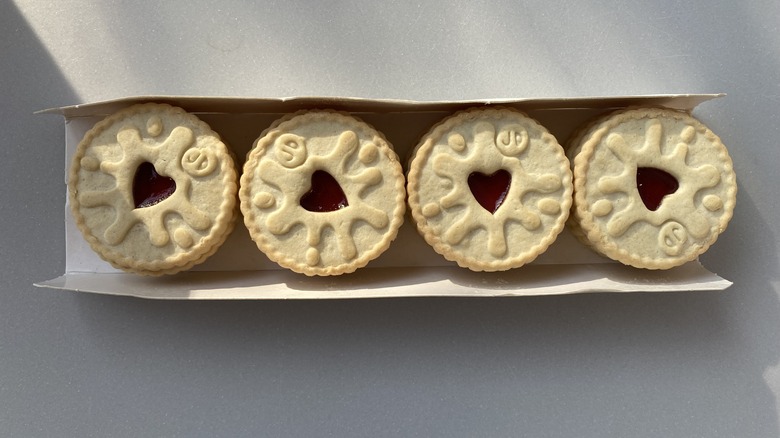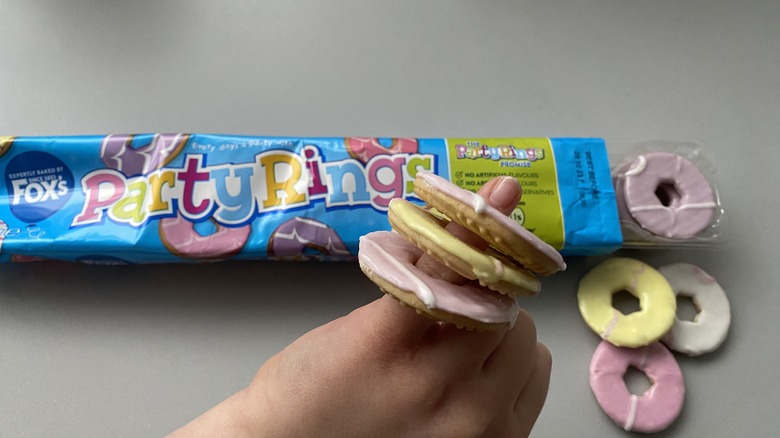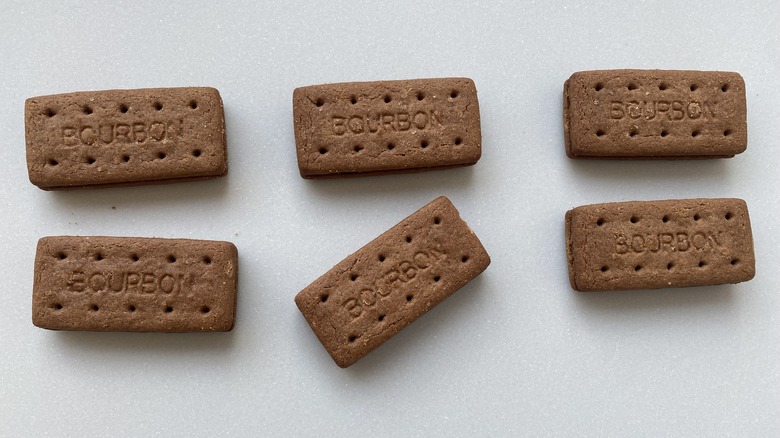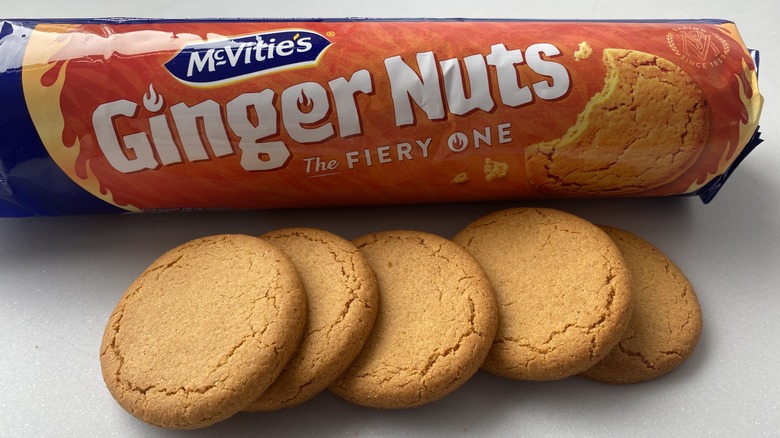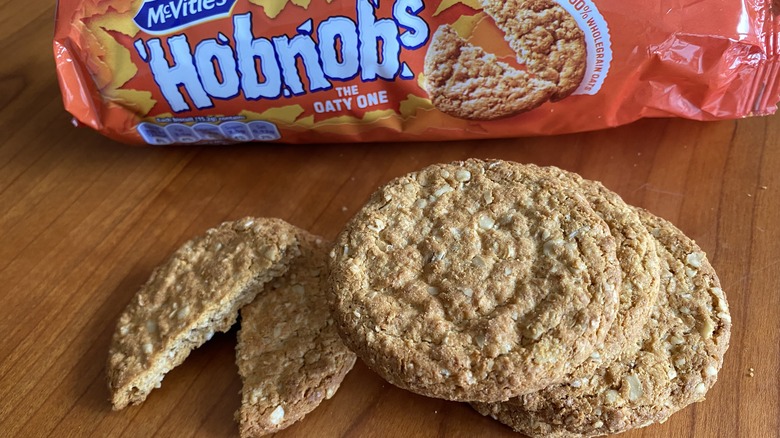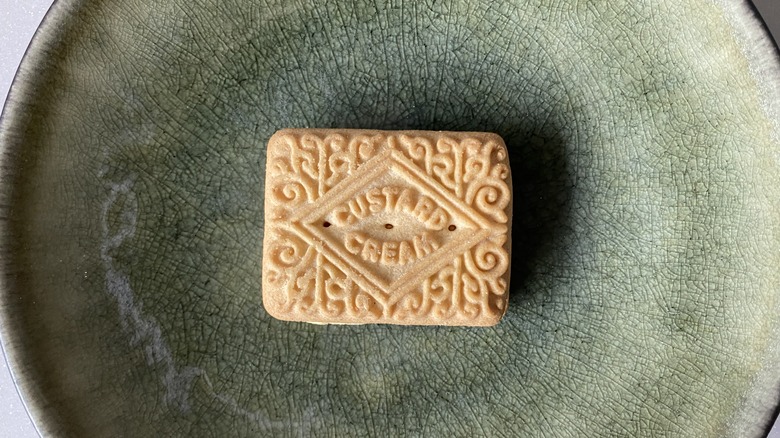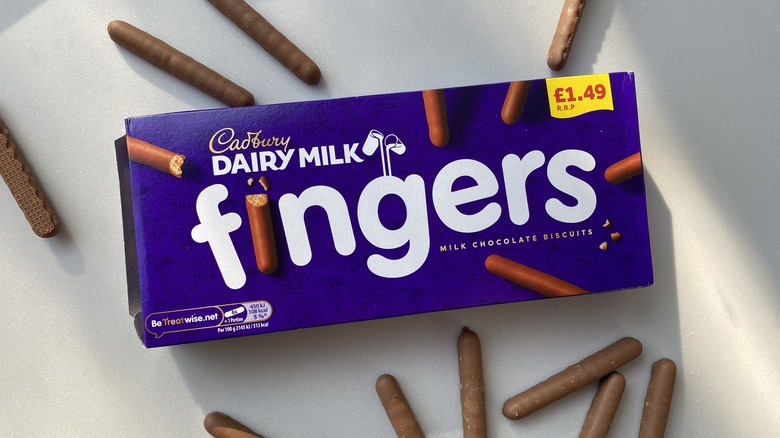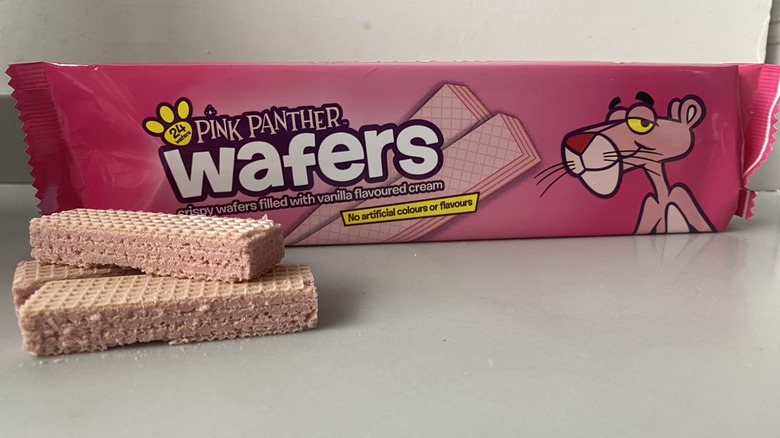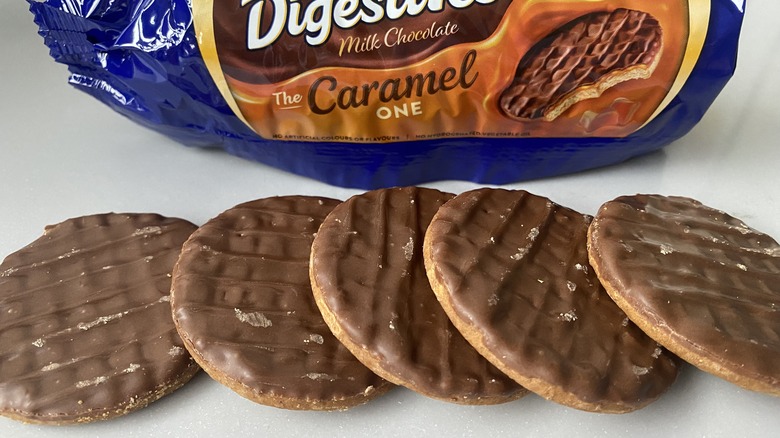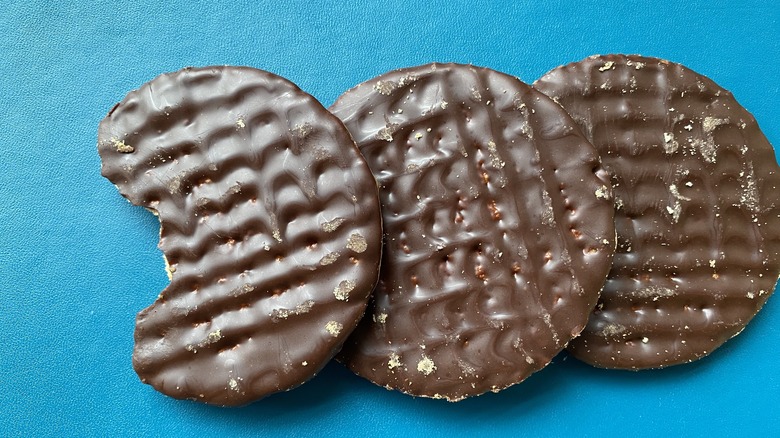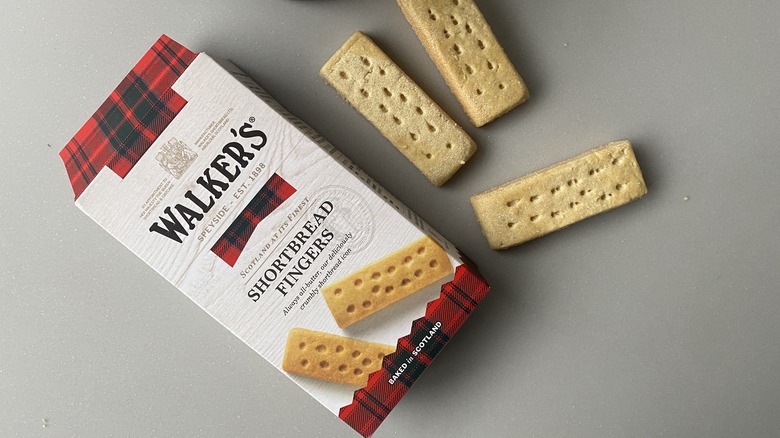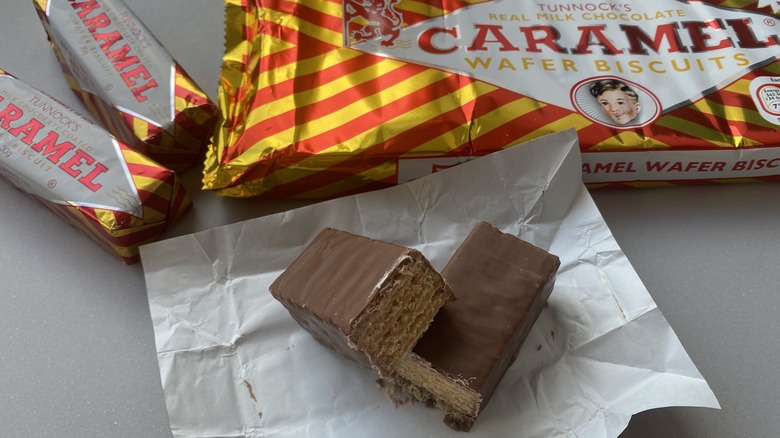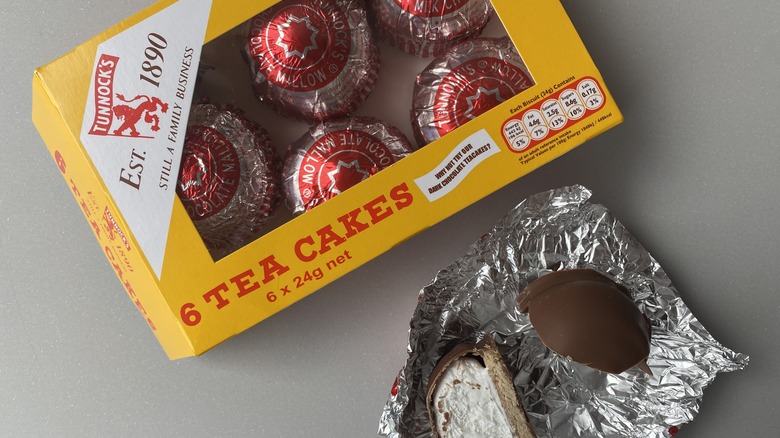18 Popular British Biscuits, Ranked
Cookies are a cultural staple in the U.K., where they are known as biscuits and are taken just as seriously as the cups of tea they are served with. The name stems from its Latin root, meaning twice-cooked. Unlike cookies like biscotti, whose name in Italian also means cooked twice, most biscuits in the U.K. are only cooked once. However, unlike cookies in the U.S., which are often praised for their soft, chewy texture, British biscuits tend to come with a satisfying snap or crunch.
This tea and biscuit ritual is even given a dedicated time of day, known as "elevenses," during which many take a short, culturally-accepted pause for a drink and a slightly sweet snack. Before the industrial revolution, a break at 11 o'clock usually involved alcohol. However, once tea became more accessible to the working classes, caffeine boosted workers' productivity.
Even Paddington and Winnie the Pooh break for elevenses to enjoy a cup of tea and something sweet. Here are 18 famous biscuits in the U.K., ranked from worst to best, according to our tastebuds. Feel free to try them all and judge for yourself.
Wagon Wheels
Having only tried a Wagon Wheel biscuit once in our lives, we can safely say if we never eat them again, it will be too soon. While some may point to the biscuit's size as one of its bonuses, its cloyingly sweet taste flips the script; it's just too much biscuit!
This seems to be a classic case of too many great ideas and not enough restraint or editing. Wagon Wheels are made up of saucer-sized biscuity bases and a layer of fruity, raspberry-flavored apple jam, followed by a thin layer of marshmallow and all coated in a firm milk chocolate shell. Put any two of these components together and we'd be jumping for joy. Sadly, we feel the folks behind Wagon Wheels took it too far — like a child who overindulges at a birthday party and then feels a bit queasy later on. In this particular case, more is not always more.
Malted Milk
Malted Milks originated with Elkes in Staffordshire before they sold the company to now-popular manufacturer Fox's Biscuits. Named after its prominent malted and milky flavor, which is derived from barley malt extract combined with milk powder, the biscuits still come stamped with pictures of cows nearly 100 years after their inception.
While we respect their place in history, and the simplicity of the malted milk biscuit, this treat has some hard limits on what it can and cannot do. In our opinion, malted milk is good for two particular purposes: Firstly, it is a classic tea-dunking biscuit, and we would happily accept one to do just that. Secondly, crushed and combined with melted butter, we also think it would make a brilliant cheesecake base. However, unless they came as a cheesecake or with a cuppa, we'd likely politely decline one if offered.
Jammie Dodgers
While it makes sense that these biscuits feature a dollop of "jam" in their heart-shaped centers, the name stems from British slang. Time Out Manchester notes that "jammy" means lucky and the name was derived from one of the characters from a popular children's comic, "Beano." The character is known for his ability to wriggle his way out of mundane tasks like homework or household chores, so he's called "Roger The Dodger." According to public opinion, those working in the famous biscuit factories were considered lucky or jammy. The name, altogether, signals luck, as any child with a biscuit in hand would agree.
These biscuits are geared toward sweeter palates, which is why, according to Biscuit People, they are known for being the most popular children's biscuits. Thankfully the same raspberry apple jam used in Wagon Wheels is balanced out with the buttery short biscuit. Though we stuck with the original flavor for this particular list, Jammie Dodgers now come in a wide variety of flavors from Cola Bottle to Cherry to Choccie (meaning chocolate).
Party Rings
Attend any children's party under age 10 in Britain, and you'll likely find a pack of Party Rings. Since they first went to market in 1983, Party Rings have become a regular part of celebrations.
These crunchy, inoffensively sweet snacks come in two sizes: The mini size, portioned into individual-sized packs, is perfect for tucking into party bags. The real joy, however, lies in the regular size Party Rings. Their perfect pinky-finger-sized circumference, durable crunchy texture, and cheerful pastel-colored icing designs are best eaten when stacked up like rings onto the sticky fingers of the little party-goers, then nibbled off. It is practically the only way to eat them, and, undoubtedly, the best way to extract as much joy as possible from the process.
Though they are not necessarily memorable in their taste, eating Party Rings biscuits without the association of happy memories is nearly impossible.
Bourbons
Bourbon biscuits first entered the British market in 1910 and were the first commercially sold sandwich biscuit in the U.K. Bourbons can be described as a perfectly fine crunchy chocolate biscuit with a thin layer of chocolate cream. Formerly given the name Creola, Foods of England says the name was later changed by manufacturer Peek Freans to "bourbon" likely in an attempt to evoke feelings of sophistication, both in its likeness to French and its reference to the aristocratic French family. According to Biscuit People, the name actually stems from the French beurre bon, meaning good butter.
Like single stuffed Oreos, this biscuit begs to be dunked. A bit dry and chalky on their own, Bourbons become infinitely more satisfying after being briefly swished through a glass of cold milk or a hot cup of tea or coffee.
Ginger Nuts
Ginger Nuts (not to be confused with gingerbread) first debuted in the U.K. around the 1840s. Their unique name refers to their golden, red-ish color, associated with the British nickname for redheads.
Ginger Nuts are another highly dunkable biscuit. Though slightly lackluster on their own, the spiced biscuit is brilliant when paired with a drink, preferably black tea with a splash of milk. With a strong ginger taste, a good crunchy texture, and the ability to soak up the equivalent of a mouthful of tea with a single dunk, ginger nuts are a firm favorite amongst many adults in the U.K. looking for a little something to pair with their elevenses cuppa. That said, when tested out amongst the younger, non-tea-drinking folks, they tended to fall a bit short, especially when compared with anything brightly colored, marshmallow-filled, or covered in chocolate.
Rich Tea Biscuits
Where this distinctive-yet-paradoxically nondescript biscuit falls on the list is entirely based on the answer to one question: Will it be consumed alongside a cup of tea? If yes, this baby flies straight into the top half of the list. If the answer is no, it will likely be found dragging toward the end, listed under the category of "better than nothing" — but still ahead of Wagon Wheels!
This biscuit doesn't perform well as a solo act, but it is a solid partner for a duet alongside a nice cup of tea, coffee, or even a glass of milk. It is objectively a dunking biscuit and should be treated as such. Subtly sweet, malty, and very dry on its own, the biscuit immediately absorbs whatever liquid it's dunked into to become a decadent, moist treat. According to Country Life, a study conducted by Guru Magazine found that Rich Teas can last for up to 20 seconds in a cup of hot liquid before they begin to waver; that sounds more like a soak than a dunk!
Hobnobs
The British really seem to excel in giving their biscuits memorable names. Case in point: Hobnobs. The term "hobnobbing" has changed over time, originally meaning "to drink to each other," then slowly morphing to mean to take turns buying rounds of drinks, and eventually meaning to socialize with people from higher class or social status.
The Hobnob biscuit introduced its biscuits to the British public in 1985. This was a few decades after Hobnob producers McVities were hobnobbing themselves, which according to the brand, resulted in making the wedding cake for the late Queen Elizabeth and Prince Philip Mountbatten. The royal cake was later distributed amidst the post-WWII rationing that was still in place in 1947. Anyone else marrying at that time who wasn't royalty often resorted to using cardboard facades instead of real cake, due to post-war rationing.
These hearty, oaty biscuits have a slightly caramelized taste. Hobnobs taste almost wholesome due to their inclusion of whole oats. Textured and rustic, these are a solid biscuit for dunking, but one we'd happily accept on its own as well, especially if offered one of their chocolate-coated varieties.
Custard Cream
Brought to market in 1908, this classic-if-not-slightly-old-fashioned biscuit is known for its etched design and the lightly flavored vanilla cream center. In 2007, the BBC reported that 90% of the 7,000 people surveyed claimed custard creams to be their top biscuit. It is impressive for such a simple biscuit, yet it has a unique quality. It's hard to find other biscuits holding their own with and without a cup of tea.
These light and crisp biscuits consist of two crunchy shortcrust biscuits with a thin layer of cream infused with custard powder in the center. When dipped into a cup of coffee, there is a faint similarity to tiramisu in the vanilla biscuit-meets-bitter-liquid kind of way. A popular choice amongst children and adults, they are sweet, but thankfully not painfully so, unlike some of their counterparts that are marketed exclusively towards children. Custard creams are the perfect example of less is more; their top biscuit status is derived from their simplicity.
Cadbury Dairy Milk Fingers
Cadbury Dairy Milk Fingers are popular chocolate biscuits that are another children's birthday party staple in much of the U.K., whether used to decorate cakes or to be eaten on their own. They now come in an eye-watering wide range of flavors from Turkish delight to pineapple, but it is the classic chocolate flavor that is the children's party favorite.
You can see why children like them; the texture is just as appealing as the taste. The ratio of biscuit to chocolate is just enough to make them satisfying, but not sickly sweet, as long as you don't eat more than a few. After consuming about three or so, the milk chocolate becomes a bit overwhelming. The dark chocolate version offers an even better balance for the older, less sweet-tolerant, and more savory-leaning palate.
Overall, we give these chocolate biscuits a good rating. They are a well-designed product that we'd be happy to nibble on while wading through any overstimulating children's party.
Pink Panther Wafer
Don't be fooled by their Peptobismol-colored exterior; Pink Panther wafers aren't strawberry or bubble-gum flavored. It's amazing how a bit of food coloring can help transform a very simple vanilla wafer into something that children covet. This vanilla wafer became a popular biscuit amongst children, making its way around the snack aisle and birthday party circuit since the 1990s. Having disappeared from shelves due to a change in supplier and rebranding, the biscuit returned to grocery store shelves with an even more robust sweet vanilla flavor, due to a change in the recipe.
Unsurprisingly, Pink Panther Wafers are a biscuit made for children, from their name to their color, and, of course, their taste. They are very sweet; however, there's something about the texture and the balanced ratio of two-thirds cream to one-third wafer that just keeps us wanting more. They're light, crunchy, and creamy; the texture variation is incredibly satisfying — as is peeling off each layer with your teeth.
Jam'n Cream
This is a biscuit for those who may have aged past their sweet baby teeth but are longing for a way to relive some of their nostalgia with biscuits. Jam'n Creams are a hybrid biscuit of Custard Creams meets Jammie Dodgers, achieved by cherry-picking the best attributes of each biscuit and then combining forces. Open up a package of these — or any like them (many brands replicate this combination) — and you'll find a slather of vanilla cream and a small dollop of raspberry jam sitting between two shortcrust cookies, complete with the desired textural snap or crunch associated with most British biscuits.
Fox's, the makers of these childhood-meets-adulthood-inspired biscuits, has been at it since 1853 with their ubiquitous brandy snaps. According to the website, the manufacturers produce more than 6 billion biscuits annually, divided between varieties. With the U.K. population at an estimated 67 million, there are significantly more biscuits on the island than there are people!
Jaffa Cakes
While we have included Jaffa Cakes on our list of biscuits because they act as such, legally, they are classified as a cake. McVitie's went so far as to go to court to retain such a title after a battle over an enforced luxury biscuit tax by Her Majesty's Customs and Excise.
While cakes were considered staples and, therefore, a non-taxable item; biscuits, especially those covered in chocolate, were not. Luxury biscuits were subject to an additional tax. McVities appealed the ruling that Jaffa Cakes were considered luxury biscuits and went to court over it. They eventually won the case and the right to be considered a cake by showcasing the differentiation in textures between stale biscuits and stale cakes. A biscuit, McVitie argues, goes soft. A cake, like Jaffa Cakes, goes hard — case closed.
Whichever you prefer to classify thee, these are top-tier biscuits. Soft, subtly sweet, spongy-like texture with a delicate hint of orange and a coating of dark chocolate over the top, Jaffa Cakes are a treat we'd be hard-pressed to say "no" to. Despite their official classification, you can find them in the biscuit aisle.
Caramel Digestives
Digestive biscuits have come a long way since their first inception, where it was touted as a digestive aid. Though the biscuit's use of baking soda was quickly disproven as a digestive aid once cooked, it did create a delicious byproduct; one which could be argued to have some gastro-aiding properties when made from fiber-rich wholewheat flour. Regardless of their uses (the name stuck as did the biscuit), which has since been adapted and changed to include all kinds of sweet variations from chocolate chips to caramel.
While we seriously doubt there are any associated health properties in these Caramel Digestives — we don't care. Layered with texture including a crunch of the biscuit, a melty-ness from the coating of chocolate, and a stretchy pull from the caramel that sits between the two, these would be perfect alongside a cup of bitter coffee. The texture and taste remind us slightly of a stroopwafel, which is never a bad thing!
Dark Chocolate Digestives
Digestives may sound like an interesting, if not slightly paradoxical, name for a sweet treat like a biscuit. Research has shown possible negative impacts on the digestive system, such as bloating or gas, when too much sugar is consumed.
The origins of this biscuit, first created in 1892 by Alexander Grant, assumed consumers would reap the digestive health benefits of sodium bicarbonate or baking soda, a leavening agent used in the biscuit. Biscuit People says that though it was later understood that bicarb was only effective as a digestive aid when used raw rather than cooked, the name "Divestives" had already stuck, even after the health benefits had been disproven.
Healthy aid or otherwise, we would happily eat this thin, dark chocolate-coated digestive on any occasion. With chocolate on only one side and the crisp, plain biscuit on the other, the balance is just right; it feels like a treat but also like one you can have at 11 a.m. without worrying about too much a blood sugar dip later on — a fantastic accompaniment to a cup of coffee or tea.
Shortbread Biscuits
Scottish shortbreads company Walker's knows a thing or two about how to produce shortbread. After all, they've been perfecting the craft since the late-19th century! The efforts have resulted in a perfectly chubby, lightly golden biscuit perfect for dunking.
This biscuit doesn't need the bells and whistles of marshmallows, chocolate, or anything else. It's perfect just as it is, with a satisfyingly rich buttery taste accented by a bit of salt, and cut into just the right thickness to achieve a satisfying snap when bitten into. Its slightly crumbly texture quickly absorbs whatever it might be dunked into, whether it's tea, coffee, or a cold glass of milk.
This is a classic, timeless biscuit that we believe will never go out of style. Thankfully, shortbread is also simple to make for those wishing to try it at home.
Tunnocks Caramel Wafer
The Tunnocks Caramel Wafer has a lot going on with five layers of wafer and four layers of thinly laid caramel, all encased in a coating of chocolate (either milk or dark). Understated, it is not. However, rather than other biscuits that seem to forsake substance over style, the makers of this biscuit knew when to stop. Each biscuit comes individually wrapped, and then tucked into a pack of eight, which manages to satisfy a sugar craving without going overboard. Notably, the biscuit's eye-catching gold wrappers also inspired the 2011 Miss Glasgow winner Amanda Quinn, who crafted her dress from the wrappers, according to Tunnock.
While it can be enjoyed with a cup of tea or coffee, as many biscuits are, it also holds up as a stand-alone treat, equally popular with children as it is with adults. Though we suppose in theory it could be dunked, we wouldn't recommend it. This is a biscuit that benefits from its crunchy light texture, which would dissolve in seconds once dunked.
Tunnocks Tea Cakes
Tunnocks, now known for its irresistible nationwide treats like the Caramel Wafer, and the Tea Cake, started life as a simple bakery. Opened in 1890, its first brick-and-mortar location was destroyed by fire. The company rebuilt in a new location at Loanhead Mansions in Uddingston, eventually serving as a home to the business's first tearoom, which proved highly successful. Archie, son of the founder Thomas Tunnock, eventually took over his father's passing in 1921, creating the Carmel Wafer in 1952. Let it be said that the Tunnock family was known for their palates. In 1956, Archie's son Boyd came up with the idea for the Tunnock teacake, making Boyd one of our favorite inventors.
Tea cakes have made it to the top of this list for various reasons. They are light and fluffy due to the generous amounts of marshmallow but are balanced out by a slightly soft biscuity base within a thin, crisp chocolate coating. While not for dunking, these are delicious stand-alone biscuits. Though we've included their milk chocolate version here, lovers of dark chocolate should bypass the milk chocolate for the more bitter version.
